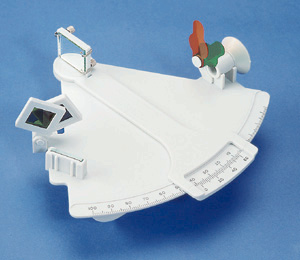Plastic sextants have a bad rep. This is not entirely undeserved, but some of the bad reputation which plastic sextants have is plainly spurious. One of the most frequent complaints I've heard about plastic sextants is that if you leave them out in the sun, the plastic expands and thus degrades your sight. Yes, plastic left in the sun will expand. However, it will tend to expand evenly, so this should not actually effect your sight. Also, no navigator worthy of the name is going to leave any sextant out in the hot sun, so the point is moot. What is not moot is the fact that plastic worm-gears (or even plastic-on-metal worm-gears) are too malleable for the precision desired of a sextant. The good news is, the cheapest plastic sextants don't have worm-gears. If you happen to own a plastic sextant which does have worm gears such as a Davis Mark 15 or 25, it is still possible to get a useful line of position with it, it just takes a lot more work. David Burch's excellent How to Use Plastic Sextants gives superb instructions for how to use these instruments, and if you'll pardon a bit of shameless self-promotion, if you purchase any plastic sextant from Starpath they'll throw in the book for free.
The Davis Mark 3, on the other hand, retails for $50 and is about the very least thing that could ever consider itself to be a functioning marine sextant. It is made out of stamped plastic and held together with model airplane glue, and has only one significant moving part, which is its saving virtue. There is no worm-gear, just a simple pivot point, and instead of a traditional micrometer drum to read minutes of arc it has a very simple vernier scale. The Mark 3 isn't pretty. It doesn't seem to work in the same way as a more traditional sextant (although the basic principles are the same), has no telescope, and instead of a beam-splitter or a traditional split horizon mirror has a simple glass mirror and thin air. In spite of this extreme simplicity (or rather, because of it), if proper sight-averaging techniques are used, the Mark 3 will yield results very comparable to those of an aluminum or brass sextant of $1000 or more. Neither of Davis' more expensive sextants can make this claim. The Mark 3 was originally developed for the US Navy as a lifeboat sextant, but given that the competition for any sextant now is a $100 GPS receiver, the Mark 3 has to be considered a serious first choice of a sextant for routine ocean navigation.
I had intended to include the Ebbco sextant (pictured above) in this discussion as well, but while it is of similar construction to the Mark 3 it does have a traditional micrometer drum, which implies plastic worm gears and springs. My recollection of this instrument is that it performed comparably to the Mark 3, but I don't happen to have one easily available so I'll belay comment on it until I do.
For the dockside and on-the-water tests of the mechanical watch I'll be using a Davis Mark 3 sextant, and I've decided to use the seven-star method of sight reduction using Pub 249 vol 1 since it is the simplest and least expensive means of deriving a 3-body fix anywhere in the world.
Also for the tests I will be using standard Universal Plotting Sheets, and a standard set of dividers and parallel rulers. I am not however including these in the cost of the method, because these would (or should!) be a part of any boat's navigation equipment for an ocean crossing.


No comments:
Post a Comment